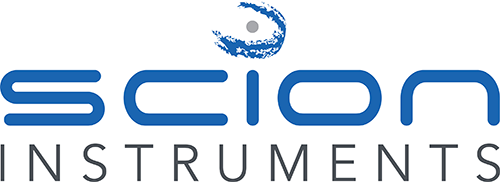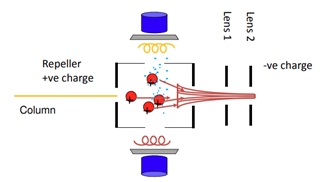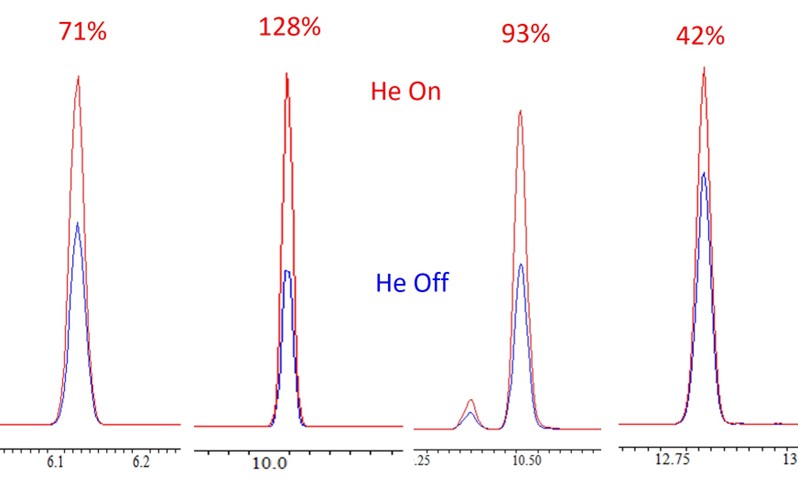How does the SCION Instruments 8700 Single Quad Mass Spectrometer work?
What is mass spectrometry?
Figure 1 Inside of the Mass Spectrometer
All mass spectrometers are comprised of at least four parts, the transferline, the ionization source, the quads and the ion detector (figure 1). These four parts are all in a vacuum chamber, to ensure a friction free environment for the ions to ‘float’ through.
Transferline
The column passes into the heated transferline (Figure 2) through the repeller and into the source. The transferline features dual heaters for fast heating, while the repeller holds and aligns the source in place.
Figure 2 Transferline
How does ionization work in mass spectrometry?
At the ionization source, electrons generated from the filament ionize the gas-phase molecules, converting them into ions and fragments. The reflector behind the filament ensures that the ions move in the correct direction. The repeller accelerates the generated ions toward the quads, and the lenses focus the ions (Figure 3).
Figure 3 Inside of the source
Different ionization methods include Electron Ionization (EI) and Chemical Ionization (CI). EI is the most common technique, often causing significant fragmentation of sample molecules.
Chemical Ionization (CI) uses a softer ionization method that produces less fragmentation, making it beneficial for analyzing larger, more complex molecules with simpler spectra.
Quads
After ionization, the quads separate the ions. First, the Quad 0 (Q0) separates the ions, followed by separation with Quad 1 (Q1).
The Q0 is specifically designed to enhance the accuracy and robustness of the SQ through pre-filtering. By using Q0 for pre-filtering, the main quad (Q1) stays clean, which reduces interference.
The curved design of the Q0, at a 90-degree angle, reduces noise and deflects unwanted neutrals out of the quad, improving mass stability.
At SCION Instruments, we offer a premium heated Q0 with He-Gas (Figure 4). Adding He gas enhances overall sensitivity.
Figure 4 Q0, He on/He off
In the Q1 the ions with specific m/z ratios are filtered. Ions that are outside the m/z range are lost in the quad, mass filtering.
The Q1 or mass filters, consist of four rods with a lens-free path design which are separated into three parts. The pre filter ion guide, the mass filter and the post ion filter ion guide (figure 5).
Figure 5 Q1
An ion has a unique mass and charge ratio (m/z). The four rods create an electric field. The ions ‘float’ through the middle of this field. By determining the correct parameters for the RF (Radio Frequency) and DC (Direct Current) voltages only ions with a specific m/z ratio will be stable and ‘float’ through the Q1 and pass to the detector. Other ions will be deflected and removed.
The DC voltage provides a constant electric field that helps in stabilizing the ion trajectories. The RF voltage creates an oscillating electric field by alternating at a high frequency, this helps filtering the ions based on their m/z ratio.
Figure 6 filtering ions in Q1
This specific combination allows the quad to selectively filter the ions (figure 6), making this a powerful tool for the SCION Instruments mass spectrometer.
Ion detector
The separated ions arrive at the detector, which sends a signal detected by the software. SCION Instruments uses an electron multiplier detector with Extended Dynamic Range (EDR).
Different scan modes
Fullscan, measures all the ions in a chosen mass range. Using Fullscan is best for identifying new/unknown components. This results in a spectrum of a specific compound. The library search in MSWS is a useful tool with Fullscan measurements to find the corresponding compound.
Selected Ion Monitoring (SIM) measures only selected/chosen masses this goes from one mass to another mass. SIM mode is usually used when you have known compounds with their corresponding masses. SIM will give a higher sensitivity and a lower noise result because it will only look for that specific mass.
Why should you choose for the SCION 8700 SQ-MS?
These are the main reasons why you should choose the SCION 8700 SQ-MS.
1. The SCION SQ-MS has a lens free Ion path this increases sensitivity by reducing ion losses, leading to more accurate quantification and identification. No lenses or apertures to contaminate this means easier for use.
2. The SCION SQ-MS has an Extended Dynamic Range (EDR), enables optimal detection in every scan, accommodating both trace components and high-abundance compounds in the same run. Accurate quantitation and reliable library search results.
3. The SCION SQ-MS has a high capacity turbopump (400 L/s) which is the fastest pump down speed on the market, improving productivity in high-throughput environments.
4. The SCION SQ-MS ‘Multi-curve’ design 90° curved Q0 and 90° off-axis detector reduces the neutral noise and gives ultra-high sensitivity (S/N).
5. The SCION SQ-MS Q0 with helium active focusing provides added sensitivity in applications.
Download Technical Note – How does the SCION Instruments 8700 Single Quad Mass Spectrometer work
GC-MS Enquiry Form






